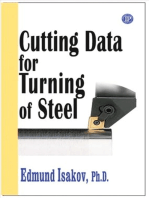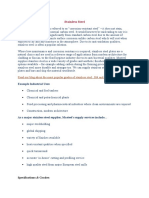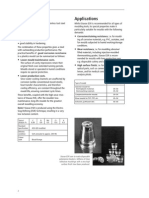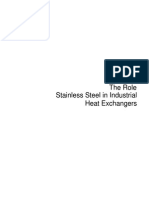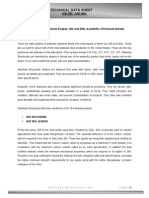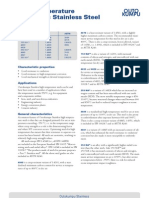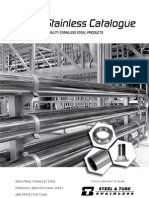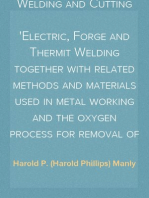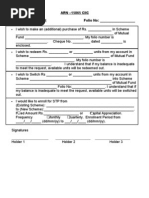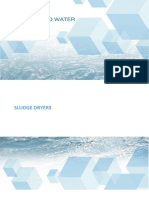SS 304
SS 304
Uploaded by
Nirav PatelCopyright:
Available Formats
SS 304
SS 304
Uploaded by
Nirav PatelOriginal Description:
Copyright
Available Formats
Share this document
Did you find this document useful?
Is this content inappropriate?
Copyright:
Available Formats
SS 304
SS 304
Uploaded by
Nirav PatelCopyright:
Available Formats
Macsteel VRN
STAINLESS STEEL PLATE, SHEET & COIL
SX304/304L Technical Data
SX304/304L Technical Data Summary SX 304 is the most versatile and the most widely used of all stainless steels. Its chemical composition, mechanical properties, weldability and corrosion/oxidation resistance provide the best all-round performance stainless steel at relatively low cost. It also has excellent low temperature properties and responds well to hardening by cold working. If intergranular corrosion in the heat affected zone may occur, it is suggested that SX 304L be used. Typical Applications SX 304 is used in all industrial, commercial and domestic fields because of its good corrosion and heat resisting properties. Some applications include:
Tanks and containers for a large variety of liquids and solids. Process equipment in the mining, chemical, cryogenic, food, dairy and pharmaceutical industries.
Chemical Composition (ASTM A240)
SX 304 304L
Mn 2.0 max
P 0.045 max
S 0.030 max
Si 1.0 max
Cr 18.0 to 20.0
Ni 8.0 to 10.50 8.0 - 12.0
0.08 max 0.03 max
Typical Properties in the Annealed Condition The properties quoted in this publication are typical of mill production and unless indicated should not be regarded as guaranteed minimum values for specification purposes. 1. Mechanical Properties at Room Temperature
304
304L
Typical Minimum Typical Minimum Tensile Strength, MPa 600 MPa 310 60 170 MPa 240 515 205 40 590 310 60 170 240 485 170 40 -
Proof Strength, (Offset 0.2 %), Elongation (Percent in 50mm) Hardness (Brinell) Endurance (fatigue) limit,
2. Properties at elevated temperatures All these values refer to 304 only. 304L values are not given because its strength decreases markedly above 425oC. Time Elevated Temperature Tensile Strength
Temperature, oC Tensile Strength, MPa
600 380
700 270
800 170
900 90
1000 50
Creep data Stress for a creep rate of 1% in 10 000 h.
Temperature, oC Stress, MPa
550 120
600 80
650 50
700 30
800 10
Maximum Recommended Service Temperature (Oxidising Conditions)
Continuous Service Intermittent Service
925oC 850oC
3. Properties at Sub-Zero Temperatures (SX304/304L)
Temperature Tensile Strength Proof Stress (Offset 0.2%) Impact Strength (Charpy V-Notch)
-78
-161 1450/1200 380/220 160/160
-196 1600/1350 400/220 155/150
MPa 1100/950 MPa 300/180 J 180/175
4. Corrosion Resistance Aqueous As a rough guide the following examples are given for certain pure acidwater mixtures-
Temperature oC Concentration, % by mass 10 80 2 1 0 2 0 0 0 0
20 20 40 100 2 0 0 0 0 2 0 0 0 0 0 0 0 0 2 60 10 80 2 2 0 1 0 1 0 1
80 20 40 100 2 2 0 2 0 2 1 0 2 2 0 0 0 0 2 60
Sulphuric Acid
Nitric Acid
Phosphoric Acid
Formic Acid
Key:
0 = resistant
corrosion rate less than 100 mm/year
1 = partly resistant - corrosion rate 100m to 1000 mm/year 2 = non resistant - corrosion rate more than 1000 mm/year 4.2 Atmospheric The performance of SX 304 compared with other metals in various environments is shown in the following table. The corrosion rates are based on a 10 year exposure.
Corrosion Rate (mm/year) Environment SX 304 Rural Marine Marine Industrial 0.0025 0.0076 0.0076 Aluminium-3S 0.025 0.432 0.686 Mild Steel 5.8 34.0 46.2
Thermal Processing
Annealing. Heat from 1010oC to 1120oC and cool rapidly in air or water. The best corrosion resistance is obtained when the final annealing is above 1070oC and cooling is rapid. Stress relieving. SX304L can be stress relieved at 450-600 oC for one hour with little danger of sensitisation. A lower stress relieving temperature of 400oC maximum must be used. Hot working Initial forging and pressing: Finishing temperature: 1150 to 1260oC 900 to 925oC
All hotworking operations should be followed by annealing. Note: Soaking times to ensure uniformity of temperature are longer for stainless steels than for carbon steels - approximately 12 times. Cold Working SX 304 / 304L being extremely tough and ductile, are readily fabricated by
old working. Typical operations include bending, forming, deep drawing and upsetting.
You might also like
- Checklist SWM Jpif DBKLDocument3 pagesChecklist SWM Jpif DBKLDak SerikNo ratings yet
- Macsteel VRN: Stainless Steel Plate, Sheet & Coil SX316/316LDocument4 pagesMacsteel VRN: Stainless Steel Plate, Sheet & Coil SX316/316LNirav PatelNo ratings yet
- SX 316 / 316L Technical DataDocument3 pagesSX 316 / 316L Technical DatavkmsNo ratings yet
- Grades of Stainless Steel - Grade 316: SX 316 / 316L Technical DataDocument3 pagesGrades of Stainless Steel - Grade 316: SX 316 / 316L Technical Data03sri03No ratings yet
- Specification Sheet: Alloy 310/310S/310H: (UNS S31000, S31008, S31009) W. Nr. 1.4845Document2 pagesSpecification Sheet: Alloy 310/310S/310H: (UNS S31000, S31008, S31009) W. Nr. 1.4845Manoj PaneriNo ratings yet
- North American Stainless: Long Products Stainless Steel Grade SheetDocument8 pagesNorth American Stainless: Long Products Stainless Steel Grade Sheettejap314No ratings yet
- Stainless SteelDocument6 pagesStainless SteelNiko NištićNo ratings yet
- SS 310Document4 pagesSS 310Madan YadavNo ratings yet
- UR35NDocument4 pagesUR35NricardodelatorreNo ratings yet
- 316 316L 317L Spec SheetDocument3 pages316 316L 317L Spec SheetLinnie Mcleod100% (1)
- SS 6mo - 1.4547Document1 pageSS 6mo - 1.4547f_riseNo ratings yet
- 304 304L Data BulletinDocument8 pages304 304L Data Bulletinmayur2708No ratings yet
- Ur 45 NDocument8 pagesUr 45 NpauldidiNo ratings yet
- Assab Stavax EsrDocument6 pagesAssab Stavax EsrAnonymous Wi2Pd2UgPINo ratings yet
- Specification Data Sheet AISI 304Document8 pagesSpecification Data Sheet AISI 304Luis Enrique Carreon TorresNo ratings yet
- Austenitic Standard GradesDocument6 pagesAustenitic Standard Gradesfierro44No ratings yet
- Stainless Steel Grade 310 (UNS S31000)Document3 pagesStainless Steel Grade 310 (UNS S31000)V BNo ratings yet
- Astm A 453 Grade 660Document4 pagesAstm A 453 Grade 660Bruno_jfNo ratings yet
- Zeron 100 Data SheetDocument2 pagesZeron 100 Data SheetMorgan PalmaNo ratings yet
- Grade Data SheetDocument2 pagesGrade Data Sheetamitkharb111195No ratings yet
- 431 Martensitic Stainless Steel BarDocument4 pages431 Martensitic Stainless Steel Barzulu80No ratings yet
- 1.4006 en PDFDocument2 pages1.4006 en PDFdiego.peinado8856No ratings yet
- Uns s32760Document3 pagesUns s32760NitinNo ratings yet
- The Role Stainless Steel in Industrial Heat ExchangersDocument46 pagesThe Role Stainless Steel in Industrial Heat ExchangerswholenumberNo ratings yet
- 304 Stainless Steel Technical Data SheetDocument4 pages304 Stainless Steel Technical Data SheetMani KannaNo ratings yet
- Sandvik 2re10Document7 pagesSandvik 2re10himan_chongiNo ratings yet
- Stainless Steel 1.4501Document3 pagesStainless Steel 1.4501Eduardo Paulini VillanuevaNo ratings yet
- LSS A286Document2 pagesLSS A286anhntran4850No ratings yet
- Valve Material ApplicationDocument16 pagesValve Material Applicationswapneel_kulkarniNo ratings yet
- Alloy SteelDocument7 pagesAlloy SteelRavinJohnNo ratings yet
- BOLTSDocument3 pagesBOLTSjcvalenciaNo ratings yet
- Grade Data Sheet: Heat Treatment Solution Treatment (Annealing)Document2 pagesGrade Data Sheet: Heat Treatment Solution Treatment (Annealing)katchaniNo ratings yet
- Ur2202 Lean DuplexDocument8 pagesUr2202 Lean Duplexbuffle08No ratings yet
- Data Sheet For Ss 304 GradeDocument2 pagesData Sheet For Ss 304 Grades swami100% (1)
- 304 Stainless Steel: Form of SupplyDocument3 pages304 Stainless Steel: Form of SupplyDeepak SinghNo ratings yet
- Stainless Steel - Grade 304Document4 pagesStainless Steel - Grade 304RektaNo ratings yet
- 25CR20NIDocument2 pages25CR20NIShariq KhanNo ratings yet
- Stainless Steel 304 Material Property Data SheetDocument2 pagesStainless Steel 304 Material Property Data SheetRahul SrivastavaNo ratings yet
- Chemical CompositionDocument6 pagesChemical CompositionAkbar DarmawansyahNo ratings yet
- Datasheet 316 316L Imperial Hpsa Outokumpu en AmericasDocument3 pagesDatasheet 316 316L Imperial Hpsa Outokumpu en AmericasAdvisNo ratings yet
- Mineral Wook Data SheetDocument2 pagesMineral Wook Data SheetjasonkkzNo ratings yet
- EldaDocument28 pagesEldaEldayadi Nefty Rizky ArismawanNo ratings yet
- Valve Material ApplicationDocument16 pagesValve Material Applicationari_prasNo ratings yet
- 304 304L Data Sheets 1 28 13 PDFDocument12 pages304 304L Data Sheets 1 28 13 PDFneerajtrvNo ratings yet
- A 286 PropertiesDocument1 pageA 286 PropertiesJitendra SoniNo ratings yet
- SS304 Spec SheetDocument9 pagesSS304 Spec Sheetjeff501No ratings yet
- 304 304h Data SheetDocument4 pages304 304h Data SheetHuỳnh Thanh TrườngNo ratings yet
- 201 Data SheetDocument3 pages201 Data SheetDjunanda E PrasetyaNo ratings yet
- PK2SPDocument3 pagesPK2SPEmanuelValenciaHenaoNo ratings yet
- High Temperature Austenitic Stainless SteelDocument12 pagesHigh Temperature Austenitic Stainless SteelCarlos Nombela PalaciosNo ratings yet
- CuAg0,1P PDFDocument8 pagesCuAg0,1P PDFirajfarji2481No ratings yet
- Pubs 1049240Document12 pagesPubs 1049240cooki77No ratings yet
- ST Stainless CatalogueDocument71 pagesST Stainless CatalogueBenjamin RattharojthakunNo ratings yet
- Oxy-Acetylene Welding and Cutting Electric, Forge and Thermit Welding together with related methods and materials used in metal working and the oxygen process for removal of carbonFrom EverandOxy-Acetylene Welding and Cutting Electric, Forge and Thermit Welding together with related methods and materials used in metal working and the oxygen process for removal of carbonNo ratings yet
- Advances in Solid Oxide Fuel Cells and Electronic CeramicsFrom EverandAdvances in Solid Oxide Fuel Cells and Electronic CeramicsNo ratings yet
- How To Read Pump Curves REVISITEDDocument3 pagesHow To Read Pump Curves REVISITEDNirav PatelNo ratings yet
- HVAC Guide Specifications Variable Speed Screw ChillerDocument11 pagesHVAC Guide Specifications Variable Speed Screw ChillerNirav PatelNo ratings yet
- SS GradeDocument3 pagesSS GradeNirav PatelNo ratings yet
- Vol 1B Summary 2020Document126 pagesVol 1B Summary 2020Nirav PatelNo ratings yet
- SIP Returns All Equity Funds of HDFCDocument1 pageSIP Returns All Equity Funds of HDFCNirav PatelNo ratings yet
- Transaction RequestFolio NoDocument1 pageTransaction RequestFolio NoNirav PatelNo ratings yet
- MEDSE Barlow En-5Document3 pagesMEDSE Barlow En-5DaveRandleNo ratings yet
- EXERCISE Analytical ExpositionDocument3 pagesEXERCISE Analytical ExpositionNurrida RidaNo ratings yet
- Environmental Law Outline.Document7 pagesEnvironmental Law Outline.Dan BayleyNo ratings yet
- The Soil PipeDocument15 pagesThe Soil PipeClasolNo ratings yet
- Fao Spis ReportDocument144 pagesFao Spis ReportMadan BhandariNo ratings yet
- Thermodynamic Analysis and Optimization of Geothermal Power Plants 1st edition - eBook PDF download pdfDocument69 pagesThermodynamic Analysis and Optimization of Geothermal Power Plants 1st edition - eBook PDF download pdfdrevenparbi100% (3)
- Water Softening 1712086475Document17 pagesWater Softening 1712086475andrisetiyowNo ratings yet
- Indigenous Bacillus Paramycoides and Alcaligenes FDocument56 pagesIndigenous Bacillus Paramycoides and Alcaligenes Ftomisin adebanjoNo ratings yet
- Ecohydrology and Its Implementation in Ecuador (2019)Document178 pagesEcohydrology and Its Implementation in Ecuador (2019)José Alberto Gaona CurreaNo ratings yet
- Water Cycle - Definition, Steps, Diagram, & Facts - BritannicaDocument8 pagesWater Cycle - Definition, Steps, Diagram, & Facts - Britannicakishorkoli07No ratings yet
- Giotto Water Sludge DriersDocument8 pagesGiotto Water Sludge DriersmuhammedNo ratings yet
- Syntheso HT 220 MsdsDocument3 pagesSyntheso HT 220 Msdsmila limaNo ratings yet
- PMH Design StandardsDocument33 pagesPMH Design StandardsboomdenNo ratings yet
- AirjetDocument28 pagesAirjetvasineyNo ratings yet
- Foam in The Aquatic Environment: Katerina Schilling, Matthias ZessnerDocument12 pagesFoam in The Aquatic Environment: Katerina Schilling, Matthias ZessnerkurtnewmanNo ratings yet
- SPM Biology JUJ Pahang 2012Document463 pagesSPM Biology JUJ Pahang 2012reachmya100% (1)
- MPRWA DEIR Review 3 Brine DisposalDocument37 pagesMPRWA DEIR Review 3 Brine DisposalL. A. PatersonNo ratings yet
- Solar Based Ro Water Purificattion Details-1Document109 pagesSolar Based Ro Water Purificattion Details-1MR.R. JEBA RAJNo ratings yet
- RAC IES GATE IAS 20 Years Question and Answers by S K MondalDocument128 pagesRAC IES GATE IAS 20 Years Question and Answers by S K Mondalpriyampatel2173% (11)
- Types of Theme Park Rides: Roller Coaster DesignsDocument5 pagesTypes of Theme Park Rides: Roller Coaster DesignsFilgrace EspiloyNo ratings yet
- USCG PSC Long Brief With Case StudyDocument74 pagesUSCG PSC Long Brief With Case StudyBtwins123100% (2)
- Simplified SewerageDocument54 pagesSimplified Seweragekartika tarmudiNo ratings yet
- 4CCE1ETD Energy and Thermofluids Page 1Document5 pages4CCE1ETD Energy and Thermofluids Page 1tehaank48No ratings yet
- ATAE Proceedings 2015 PDFDocument884 pagesATAE Proceedings 2015 PDFSorica CristianNo ratings yet
- MSDS Jotun Thinner No 2Document8 pagesMSDS Jotun Thinner No 2willhansen kamarga100% (1)
- Technical HandbookDocument476 pagesTechnical HandbookQOBITNo ratings yet
- Review On Two Stage Evaporative Cooler: Dr. U.V.Kongre, N.T.Neware, P.A.Bagade, N.P.IngaleDocument3 pagesReview On Two Stage Evaporative Cooler: Dr. U.V.Kongre, N.T.Neware, P.A.Bagade, N.P.IngaleerpublicationNo ratings yet
- Learning Activity Sheets Science: Quarter 3 - Week 5&6Document10 pagesLearning Activity Sheets Science: Quarter 3 - Week 5&6soobacadoNo ratings yet
